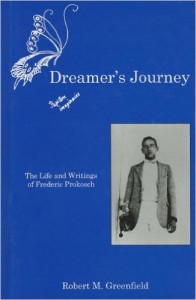 Dreamer’s Journey: The Life
Dreamer’s Journey: The Life
and Writings of Frederic Prokosch
by Robert M. Greenfield
University of Delaware Press. 465 pages, $80.
FREDERIC PROKOSCH was a novelist and poet of the 1930’s who wrote dreamlike novels capturing the decay of society. He is best remembered for his first published novel, The Asiatics, which captured public attention with its description of exotic lands. Dreamer’s Journey offers a fascinating insight into the life and work of this unusual, creative artist.
Prokosch was solitary by disposition, in social settings playing the part of either the dispassionate observer or the center of attention, charming his guests with witty, sometimes scandalous stories of various famous people, literary and otherwise, that he claimed to know quite well. In fact, as Greenfield demonstrates, he greatly exaggerated or entirely fabricated his relationship with many of them. Most he knew only through letters, which he initiated in a calculated effort to cultivate contacts throughout the literary community of which he aspired to become a member. Prokosch was an inveterate embellisher of his past, raising his family background to German nobility, when in fact he was born in Wisconsin to an overbearing scholar of a father who could not tolerate any noise, even that of his own children.
Greenfield suggests that Prokosch’s fascination with “mimicry and impersonations, hoaxes and impostors” stemmed in part from his homosexuality, which he regarded with ambivalence. His most important adult relationship was with his partner of 37 years, Jack Bady, yet at times it appeared more like a business transaction. In interviews, Prokosch would make oblique references to his sexual orientation, and even watched his own graduation from Haverford College in drag, but knew that many people would never accept him because of it.
He used this obsession with lies and disguises to great effect in his “memoir,” Voices, where he charted his literary career as an easy rise to the top, full of encounters with famous people who would engage him in philosophical discussions and reveal personal truths about themselves. In reality, the memoir is almost entirely a work of fiction, part of an elaborate hoax designed to regain the fame and popularity that had eluded the author after his early books. While The Asiatics had won him critical praise and recognition at an early age, by the time he wrote Voices his career had fallen into a sad state. His last several novels had failed to interest any publisher, and his “Butterfly Books,” beautifully bound collections of famous poets’ works, had been exposed as forgeries.
Dreamer’s Journey is a tremendous work of research, offering sympathetic insight into a gifted, complicated author who created in his work a world to match his odd temperament.






